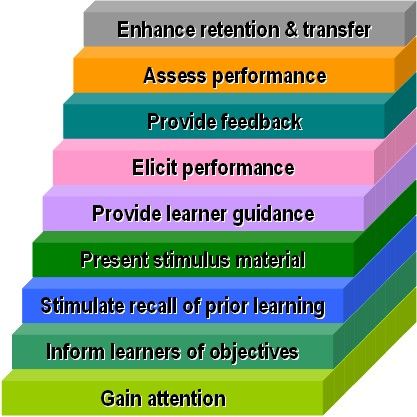As a tutor and assessor one of the main factors that drives me is seeing the development of the learners I have contact with. Learning is a journey where there is a definite shift in understanding and application of knowledge and skills. As an educator we have the responsibility for selecting key theories, techniques or methods and facilitate the exploration and application of these by our learners.
Essentially learning is a process made up of a number of stages, and as an educator key events, materials and interactions can be instrumental in the development of our learners. It also is key in ensuring a progressive layering of knowledge and skills, which progress our learners towards a fuller understanding of key concepts.
This layering process and gaining of foundementals prior to building more advanced concepts has been clearly discussed by Gagné. Who stated that for learning to effectively take place each of the following steps must be completed, and each layer satisfied before a learner moves onto the next. This model is one that can greatly aid in the understanding of learning as a process.
- Gaining attention: As an educator we must gain the attention of our learners. If a learner is disengaged communication tends to lack and this in turn reduces receptiveness to instruction. By fully engaging our learner we will not only increase the knowledge transfer, interaction and progress, but also create a much more relaxed learning environment.
- Informing learners of objectives: This is a key step that many educators miss, by detailing objectives learners are clear about the skills or knowledge they will gain by the end of the session. These also give a framework to keep discussions on topic and judge transfer at the end of a session.
- Stimulating recall of prior learning: A key concept in the retention of information is to make connections with any existing base of information on a given topic. By recapping of discussing any foundational concepts we can bring this information back to the front of the learners mind and also set a base to build from.
- Presenting the stimulus: The concepts that will make up the session are delivered in the form of any teaching or learning activity.
- Providing learning guidance: The educator helps the students in understanding (semantic encoding) by providing organisation and relevance, in the context of existing parameters.
- Eliciting performance: The educator asks the learners to respond, demonstrating learning. This may include a higher level of interaction and application of the concept to aid understanding and retention.
- Providing feedback: The educator gives feedback on the learners’ performance and understanding. where possible they may stretch and challenge the learner to try and push understanding within group and individual limits.
- Assessing performance: The educator requires a demonstration of learner performance and understanding, They then give feedback to help reinforce learning.This is really a check on learning that is being judged against the learning objectives established at the beginning of the session.
- Enhancing retention and transfer: By providing information and tasks to follow up the learning can be retained over a longer period of time. This can be done more easily in a longer courses and there is a greater flexibility for revisiting topics covered in previous sessions.
Many argue that Gagné’s taxonomy is too simple for a full understanding of the complex process that is learning. However this can be a good starting point for the exploration of more complex educational concepts and can be a good foundation for solid teaching and course design.


